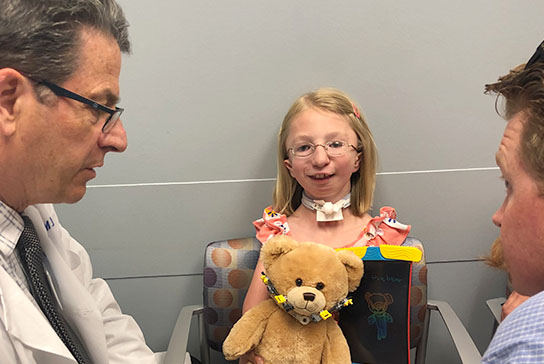Craniofacial anomalies – Noonan syndrome
It is thought that this syndrome occurs in somewhere between 1/1,000 and 1/ 2,500 newborn babies. The Noonan syndrome features are easier to see at birth and by adulthood they are often very subtle and can easily be missed.
What are the features of Noonan syndrome?
This is a variable syndrome. This means that a person who has this syndrome may not show all the symptoms. They may not even know they have it until they have a child who happens to have more of the features of Noonan syndrome. It is possible to have very few problems with this syndrome. A baby born with Noonan syndrome may have a short neck, with excess skin where the neck joins the shoulders. This can make the neck seem broad and is sometimes called "webbing." Frequently there are differences in the eyes, including strabismus (cross-eyedness), nystagmus (eye tremors) and very bright blue-green iris. The chest may be shaped a little differently, either sticking out (pectus carinatum) or sinking (pectus excavatum). There is an increased risk of some degree of hearing loss.
More serious problems include a smaller than normal jaw. This can create some feeding problems, and even in some cases lead to failure to thrive. Babies with this syndrome are also at an increased risk of cardiac defects. It is important to have a cardiac evaluation if Noonan syndrome is diagnosed.
Children with Noonan syndrome may have a coagulation abnormality. This means that the blood may not clot as quickly as it should. There is a wide range in coagulation differences, ranging from more serious problems of clotting after surgery, to easy bruising, and even to an abnormality seen in the laboratory with no known clinical consequences.
Can surgery help?
Strabismus occurs when the muscles of the eye are not lined up at the same point. Patching one eye may resolve the problem without surgery. Surgery may be performed if patching does not work.
If the lower jaw is too small it can be surgically moved. Surgery would be performed if the jaw is so small that it makes breathing more difficult. If surgery is going to be done, the age at which it happens would depend on the health of the child and how small the lower jaw is.
The type of hearing loss that can occur in people with Noonan syndrome is sensorineural (the hearing problem is in the inner ear, auditory nerve, or auditory centers of the brain). While surgery is frequently unable to improve this type of hearing loss, hearing aids can help.
Treatment for any cardiac problems is usually based on the symptoms present.
Will my child have trouble learning?
It is possible to have some learning problems and delay in motor skills with Noonan syndrome. However, 75% of people with Noonan syndrome have no learning problems at all. It is not known why some children have learning problems, and at this time there is no way to predict who will and who will not have learning problems.
Can I have another child with Noonan syndrome?
If your child is the first person affected in your family, then the change in the gene that caused Noonan syndrome may have occurred for the first time in the egg or sperm, so there is a low chance of having another child with the same condition.
Noonan syndrome is an autosomal dominant condition. This means that if you have the condition there is a 1 in 2 or 50% chance with each pregnancy that you will pass it on to your child.
This is a very variable syndrome. It is possible to have Noonan syndrome and not realize it until you have a child displaying more of the features associated with this condition. If you have Noonan syndrome, it is not possible to predict if your child will have the same, more, or fewer problems than yourself.
Is there any testing?
Changes in a gene known to cause Noonan syndrome occur in about half of the people with Noonan syndrome. In the other 50% the cause is unknown. Testing is still in the research stages only. Diagnosis of Noonan syndrome is made clinically, by looking at the features of a person.
Support groups
The Noonan Syndrome Foundation (NSF) Support Systems
Additional resources
References
- Jones K.L., Smith's Recognizable Patterns of Human Malformation. 5th Edition. W.B. Soliders Company A Division of Harcourt Brace and Company, 1997.
- Online Mendelian Inheritance in Man, OMIM (TM). Johns Hopkins University, Baltimore, MD. MIM Number: 163950: 2001:


